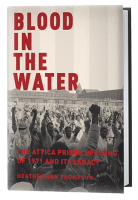A Complete Story of Attica


Heather Ann Thompson has written a magnificent history of the Attica Prison uprising, the deadliest prison rebellion in U.S. history. It is a long book, nearly 600 pages of text and another 150 of notes and apparatus. It’s a timely book: Attica casts its uneasy shadow over our halting steps to unwind the social catastrophe that is mass incarceration.
Blood in the Water embodies ten years of research. This lengthy gestation reflects Thompson’s battles with an officialdom unwilling to release any more of the documentary record than it was legally compelled to do. It also reflects Thompson’s commitment to tell this story from the vantage points of all those caught up in the Attica rising and its brutal repression. Accordingly she has given us a virtually hour-by-hour, 360-degrees-in-perspective account of the events leading up to the rebellion, the five days in September 1971 when 1,300 rebels held part of the D Block and the D Yard, and the brutal retaking and reprisals that followed. Rarely has an historian been able to reconstruct a complex set of events with such completeness. Thompson also chronicles the decades of litigation over criminal liability and compensation in the long wake of the uprising.
Then and Now
In some respects the conditions at Attica that sparked the September 1971 rebellion are unchanged. The population of the prison is today, as it was then, roughly 2,200, close to maximum capacity. Now as then, the largely urban black and Latino inmate population is overseen by a hostile, white, rural correctional workforce. Material conditions were deplorable in 1971. The men were ill-fed, ill-housed, and medically neglected. Prison wages were too low to allow prisoners to buy enough of what was not provided. Material conditions have improved at Attica, although shameful conditions obtain in many other U.S. prisons. Attica today as then is among the most racially oppressive and violent New York state prisons.
The Attica rising occurred two years before the Rockefeller drug laws were enacted. These and subsequent draconian sentencing measures drove up the number of prisoners in New York. In 1971 there were slightly fewer than 20,000 prisoners in New York state. That number peaked in 1999 at 72,000. It is now at approximately 50,000. New York repealed the Rockefeller drug laws in the 1990s. New York’s prison population has decreased by 29 percent from its height. New York is a leader among the states in curbing its prison population, one of a small handful of states with comparable reductions. Almost all the decrease is attributable to prosecutorial and diversionary policies embraced in New York City, rather than uniform reductions throughout the state. There are 2 ½ times as many people in New York’s prisons today as was the case when Attica blew up. The beat goes on.
The Riot that Became
the Attica Rebellion
The early 1970s saw a dramatic uptick in prison and jail riots across the United States. Corrections authorities in New York were confronted by riots in New York City jails and upstate prisons. In an attempt to stave off contagion, New York City inmates were shipped upstate, and troublemakers upstate were shuffled to other prisons. As a result of this churn, in September 1971 Attica was crowded, severely understaffed, and home to Black Muslims, Black Panthers, and a sprinkling of white radicals.
A security breach permitted the rebellion to launch. In the first hours, corrections officers (COs) were assaulted. There were raids on the infirmary and the commissary. Twin 19-year-old brothers were gang raped. Some men stepped up to protect COs and vulnerable prisoners in the midst of the chaos. Once the prisoners had taken control of D Yard, the 1,300 rebels quickly established order and an almost Occupy-like democracy. Black Muslims took the lead in protecting the 30 hostages. A volunteer patrol kept the peace in the yard. The men elected representatives to conduct negotiations with the authorities. All decisions were plebiscitary. Negotiations were conducted in the yard and broadcast for all to hear via a makeshift public-address system.
The negotiations were doomed from their inception, despite some unusual circumstances favorable to the rebels. Astonishingly, the authorities acceded to the prisoners’ request to invite “observers,” notables whose presence would bring public attention to their cause and their fate. Newly appointed Commissioner of Correction Russell Oswald was a reformer. He agreed to implement almost all the prisoners’ “demands” that their basic human needs be met and due process be respected. The sticking point was amnesty for the rebels. Oswald and other doves were sidelined when Rockefeller took command. No one who wanted a peaceful resolution then had power, and no one who had power wanted a bloodless resolution. Thus no resolution involving partial amnesty and limited retribution was explored. Rockefeller distained further negotiations and authorized the use of armed force to put an end to convict defiance in the full glare of national publicity. The state police and COs retook D Yard with guns blazing under a heavy canopy of tear gas. All casualties were by gunfire, all inflicted by the state’s forces. The rebels had no guns. Nine hostages and 29 prisoners were shot to death; another 128 were injured by gunfire. Thompson’s account of the bloodlust and savagery of the retaking is a remarkable piece of history. For these men whose job it was to enforce order at the ground level, the rebellion of black convicts was terrifying and enraging. (Of course) a rumor circulated just before the yard was stormed that the rebels had emasculated a CO hostage.
Governor Rockefeller’s Ambition
and the Fear of Black Radicals
Thompson traces Governor Rockefeller’s response to the rebellion to his political ambition. Rockefeller wanted to run for president. He was saddled with a reputation as a liberal in a party that was moving to the right. Attica was his chance to position himself as a stalwart of law and order. But Thompson also finds that the fear of black insurrection in the prisons and beyond was endemic in government, shared by President Nixon and Governor Rockefeller and permeating the institutions of the state. The radicals of that era would no doubt have been flattered had they appreciated how serious a threat those in power believed they posed. A tragic facet of Attica is that this mindset blinded and anesthetized so many to the privation, dehumanization, and racism prisoners endured.
Decades of Litigation
Attica had a long aftermath in which the state of New York, prisoners, hostages, and their survivors jousted in the courts over what happened, who was to blame, who should go to prison, and who should receive compensation. In short, the cover-up began before the last shot was fired, and multiple investigations were so flawed that the state had to abandon criminal charges against almost all the prisoners originally in its crosshairs. A few prisoners and lawyers showed astonishing grit and resourcefulness in pursuing compensation for the men injured in the retaking and beaten and tortured thereafter. These heroic efforts yielded modest victories some 30 years after the carnage in D Yard. These pages are full of interest. The pattern is familiar: This is a tale of official lies and cover-up, of reprisals against truth tellers and whistleblowers, and callous indifference to those with little power.
More Then and Now
Attica was and remains a maximum security prison; the majority of the 1971 rebels had been convicted of serious crimes. For this reviewer, the story of the prisoners’ manner of conducting life in D Yard is all the more significant and poignant for that fact. They demonstrated the aspirations and capabilities of those on whom society has turned its back. Thompson seems reluctant to acknowledge the import of Attica’s being a maximum security prison. She highlights examples of minor offenders thrown into the Attica mix. Then as now, it is easy to find irrationality in any prison. This shying away is perhaps the only instance of Thompson’s political sympathies coloring a history that is notably fair-minded and humane in its treatment of all its subjects (admirers of Nelson Rockefeller will disagree). I enter this cavil with both eyes on the politics of mass incarceration.
The well-advertised goal of current reform initiatives is to keep low-level, nonviolent offenders out of prison or to at least curtail their time in prison. These reforms are sold politically as protecting public safety by keeping the really bad people behind bars while also taking us out of the era of mass incarceration. However, the math does not work. There are too few minor criminals, relatively speaking, and too many violent and serious offenders in our prisons. More than half the inmates in state prisons are violent offenders. We will continue to be a gulag nation until or unless violent and other serious offenders are also treated as redeemable.
Blood in the Water could hardly be more relevant to current evasions and engagements with criminal justice.